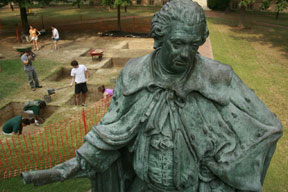Wren archeological dig continues to hit pay dirt
 Sweat equity is paying its dividends for
Steve Archer and his team of student archeologists. Archer and a half
dozen William and Mary undergraduates have spent the summer digging for
evidence of former gardens in the college’s Wren Yard and they’ve hit
pay dirt.
Sweat equity is paying its dividends for
Steve Archer and his team of student archeologists. Archer and a half
dozen William and Mary undergraduates have spent the summer digging for
evidence of former gardens in the college’s Wren Yard and they’ve hit
pay dirt.
In the last few weeks, the team has discovered evidence of an 18th century ditch, hedge rows and pathways. “It’s a really well preserved cluster of features that align really well—the ditch and the planting holes, matching with the next line of at least one tree hole,” Archer said.
The Wren Yard surrounds the oldest building on the William and Mary campus, the Sir Christopher Wren Building. The building once housed the entire college and is still in use today as an academic building.
Recorded descriptions of the grounds appearance are few. But the college did get a glimpse of one possible view in the late 1920s when researchers discovered a printing plate in England’s Bodleian Library depicting the Wren Building and its grounds. Still, little was known about the plate’s authenticity until Archer began digging for evidence two years ago.
Archer noted they found other signs of the garden. “We have sort of a consistent division where there is marl on the north half of these units (the digging squares) as we come down to the features but it’s not on the south half.” He noted this marl would be consistent with an area depicted on the Bodleian Plate between the hedgerows flanking the center pathway.
This summer’s excavation was the third conducted by student archeologists under his guidance. The first dig turned up few clues but thankfully Archer, who is also a research archeologist at Colonial Williamsburg, wasn’t deterred. Last year’s digs were more fruitful—the team found evidence of topiary planting holes and some pathways. But this year’s finds have been the most impressive by far.
The team found evidence of two, closely configured planting holes—one cutting in to the other, Archer said. “You can actually see where one of the hedge plantings died and they had to dig it out and put in a new one. It is, sort of, a repair there to the hedging; you can actually sort of see them maintaining the garden a little bit, which is a neat find.”
With the answers to the mystery of the Bodleian Plate seemingly in hand the team is turning its attention to what might have been the next design.
“What’s a little intriguing is that we keep getting hints that go in and out about what was happening out here in the late 18th century.”
The team also found evidence this summer of two diagonal walkways—one believed to be a 19th century path that is on a line that would have connected the Wren Building to the Brafferton and an 18th century one. The amount of fill found with the 18th century feature suggests that it was the active path between the Wren Building and the Brafferton in the late 18th century, Archer said. “[That] means the formal garden (the one depicted in the Bodleian Plate) would have been gone by then,” he said. “So we are trying to get the tail end of that Bodleian Plate design. “It’s all little bits and pieces; you have to find out how everything fits together.”
Even with the new questions, the summer’s dig answered a lot. “We’ve made a lot of progress…I’m really happy the way the summer has gone,” said Archer.














